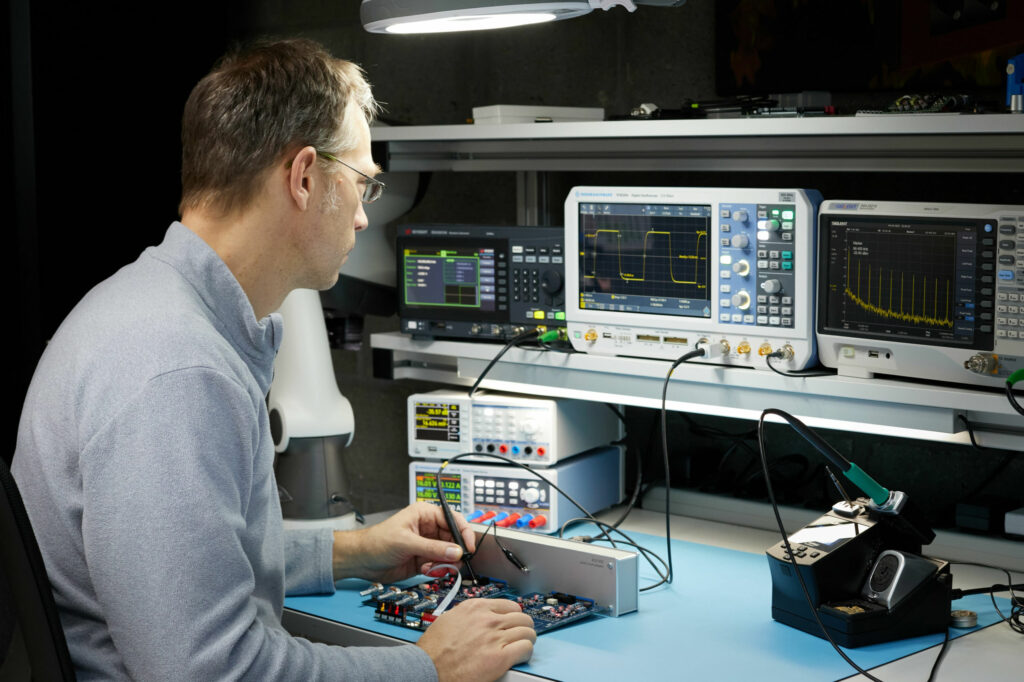
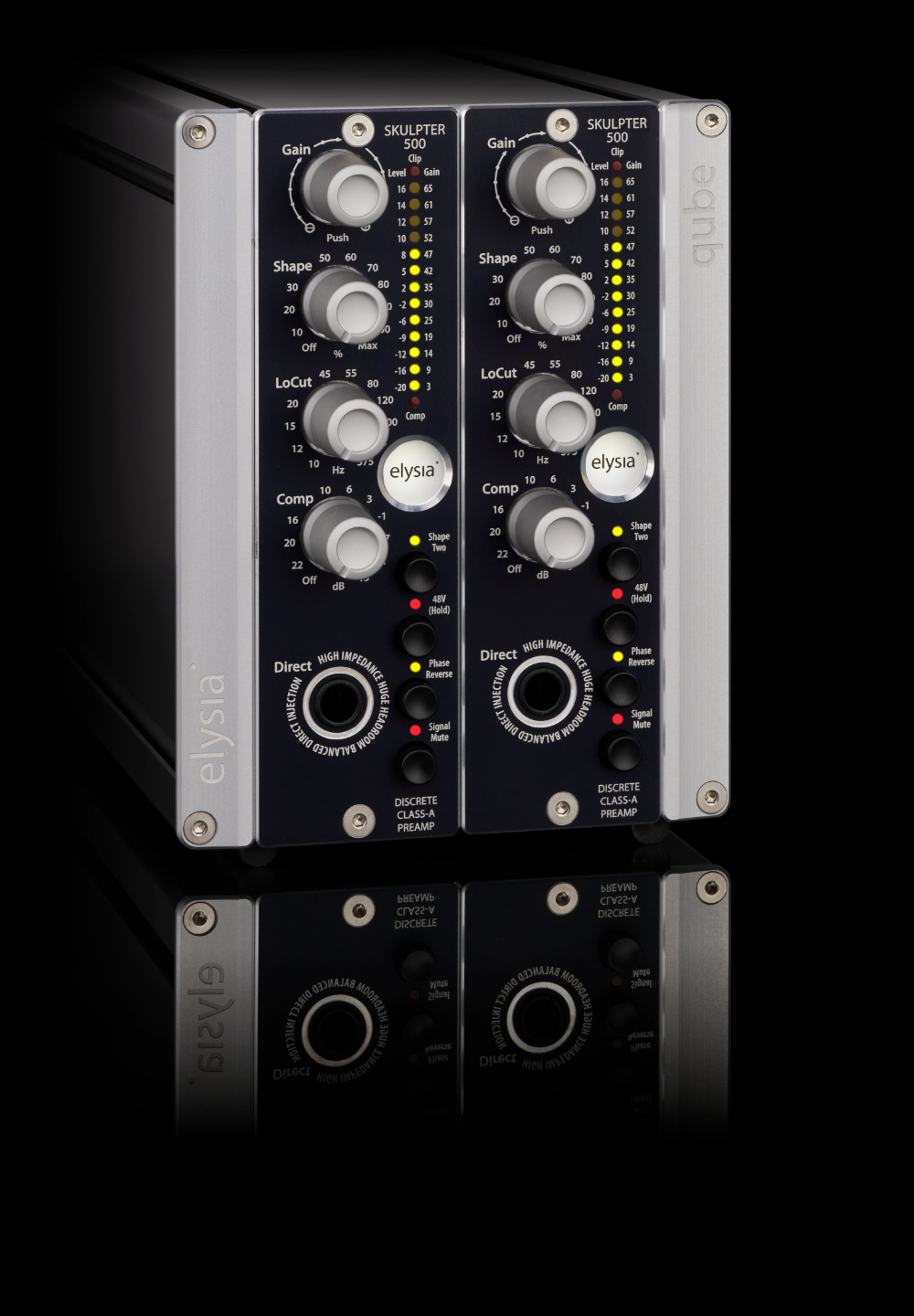

By loading the video, you agree to YouTube's privacy policy.
Learn more

By loading the video, you agree to YouTube's privacy policy.
Learn more

By loading the video, you agree to YouTube's privacy policy.
Learn more

By loading the video, you agree to YouTube's privacy policy.
Learn more

By loading the video, you agree to YouTube's privacy policy.
Learn more

By loading the video, you agree to YouTube's privacy policy.
Learn more
skulpter can make your recording experience like you’ve always wanted it to be!
Choose between different examples including applications like recording, mixing, use good headphones or speakers. Just press Play and A/B between the bypassed and active sounds!
Featured artists in these examples: GiveUsAnimalNames, Herr K und die Verstärkung
Note: If you have technical difficulties and don't hear audio playing back, you may want to switch off silent mode on your mobile device.
skulpter uses an audiophile topology for setting gain: Fixed resistors switched by a cascade of relays and electronic switches.
This setup is controlled by an encoder with 20 steps per rotation, providing a total of 40 gain values in 1.5/2 dB steps (total gain range: 3 – 65 dB).
The actual mic preamp and the direct input have a separate gain value each. If you change from Mic to DI or vice versa, the gain will automatically change accordingly.
When skulpter is powered off its current gain setting is saved automatically, so the preamp will start with exactly the same amount of gain on the next session.
The very open and natural sound character of skulpter can be shaped by two independent combinations of saturation and tweaked filter curves:
Shape One: Instruments
The first ingredient to achieve that big, fat sound is adding harmonics (THD). The intensity of this saturation is determined by the input level and the amount of preamp gain. The resulting sound is huge, with a massive body but no harsh peaks at all.
Shape Two: Vocals
Vocals benefit from the same saturation enhancement; and, like a tube-like characteristic curve, this results rather in musical soft clip limiting than in actual distortion.
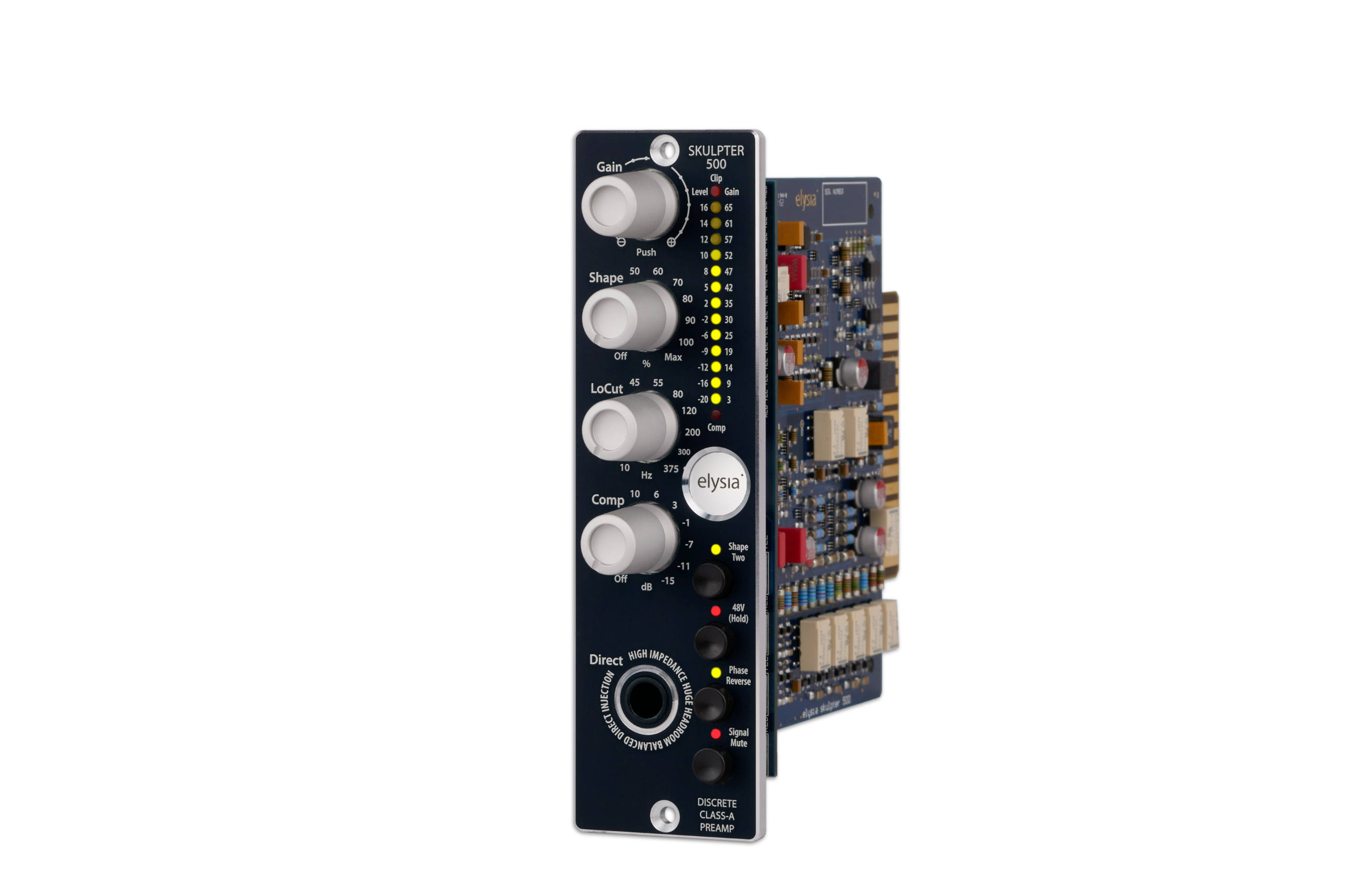
An essential standard tool for any preamp is a low cut for reducing low frequency rumble.
Instead of just a single or maybe two fixed frequencies, skulpter offers a variable low cut filter with a wide frequency range from 10 Hz to 375 Hz.
The slope of the filter is 12 dB/octave, and its amplifier is a discrete class-A design optimized for especially transparent performance.
The Phase Reverse function has been designed to eliminate the need for an additional inverting amp.
This means that reversing the phase will not add any additional circuitry to the signal path, so the sound will remain the same in both positions of the switch.
Switching the phase from normal to reverse (or vice versa) will automatically trigger a signal mute for a few milliseconds to avoid cracking and popping noises.
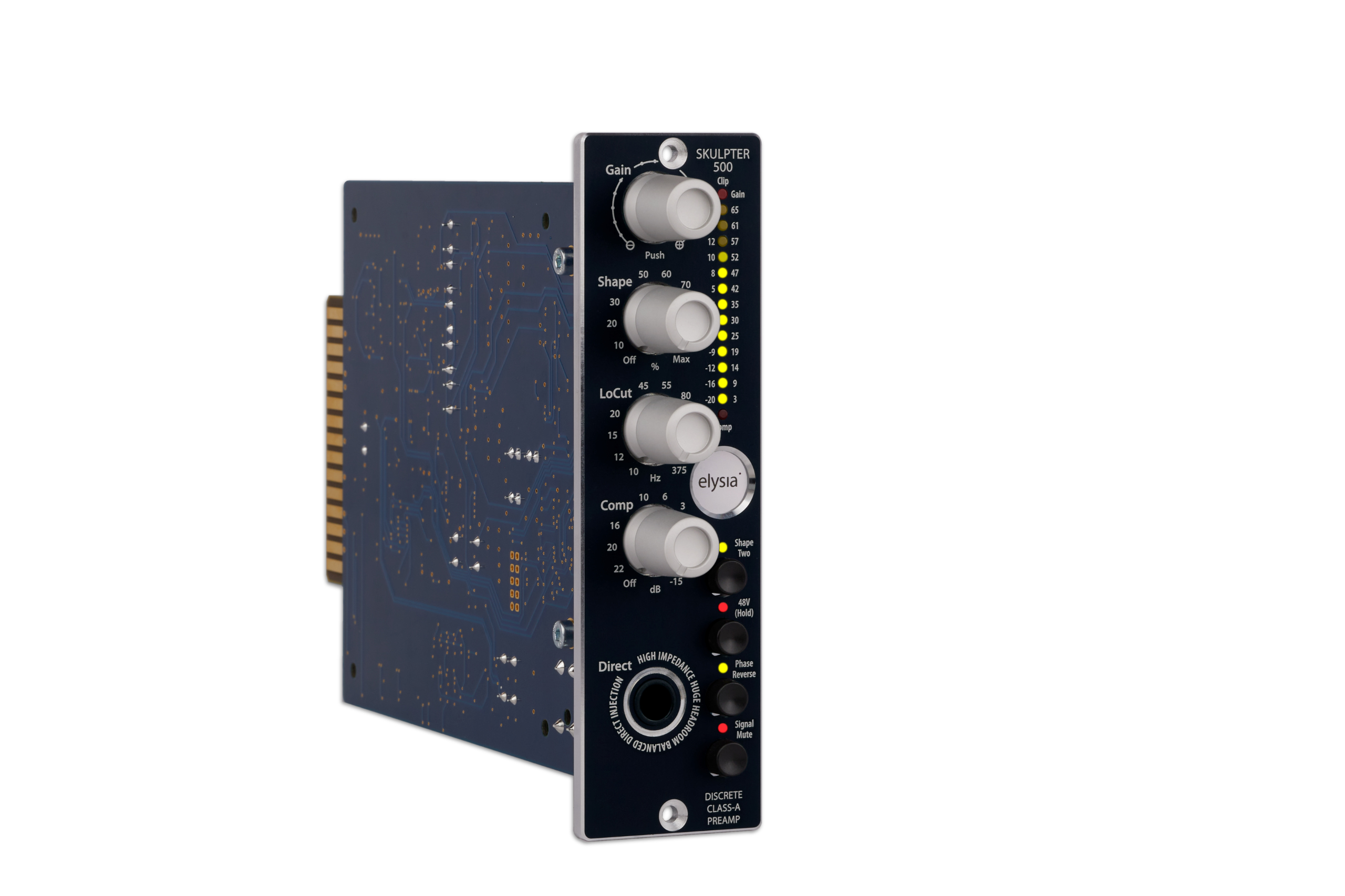
An integrated compressor operated by just a single knob. Its potentiometer sets the threshold based on a fixed 3:1 ratio and a soft knee characteristic.
The all discrete class-A circuitry provides a premium quality audio path, and the RMS detector has been optimized to react noticeably well on vocals and instruments.
This alone makes for a very musical and unobtrusive dynamics section on a par with the best compressors the market has to offer.
The compressor’s easy one-knob-operation is supported by elysia’s signature Auto Fast function, which will automatically reduce the attack to its shortest value when strong impulses and transients require it.
An integrated front panel JFET DI makes it perfect for amplifying and shaping many kinds of different signals coming from guitars, basses, synths, effects…
The high input impedance of one megohm allows users to directly plug even instruments with passive pickups into the preamp without the danger of a mismatch causing dull and lifeless sounds. On the other hand, the input can handle high levels of up to +19 dBu!
The high amount of headroom and the fact that you can feed both balanced and unbalanced signals into this DI make it the perfect terminal for line signals – which will benefit big time from the purity of skulpter’s preamp with its amazing sound shaping and dynamics features.
Pressing the mute switch instantly reduces the output level to zero. While in this state, instruments can easily be changed on the DI, cables can be swapped, mics can be replaced by others – without blowing ears or speakers.
In addition, the mute function comes in really handy for canceling source signals from the recording room when silence is needed for listening to playbacks.
Apart from the dedicated switch, the elysia|skulpter automatically soft starts with the mute function enabled for a short moment, which avoids nasty surprises when powering up.
skulpter generates its own 48V phantom power on board, so this critical supply voltage is completely independent from the quality of the specific rack frame being used.
Whenever phantom power is switched on or off, skulpter shortly mutes its output to avoid cracking and other unwanted noises in the signal chain.
Note: In order to avoid accidentally activating or deactivating the phantom power supply, the corresponding button must be pushed for a period of 2 seconds to toggle its function.
The fifteen LEDs of skulpter’s meter provide four pieces of vital information:
Input Clipping: A single LED located at the top of the meter will light up if clipping is detected at the input of the preamp. If the input does not clip, it means that the rest of the signal path is good as well. The LED increases in brightness to reflect the intensity of the overload.
Compression Intensity: Another single LED located at the bottom of the meter shows the amount of compression applied to a signal if the dynamics section of skulpter is active. This LED also changes in brightness to visually represent the amount of compression applied.
Level Meter: Thirteen LEDs in the middle of the meter show the output level of the preamp. For smooth transitions between different values instead of erratic flickering, these change in brightness, too. Level related effects of the compressor and sound shaper sections can be monitored on this meter as well.
Gain Indicator: If the Gain encoder is pushed, the level meter will turn into a gain indicator. In this case, the scale printed on the right side of the LEDs will apply, and the meter will show the amount of gain the preamp currently generates.
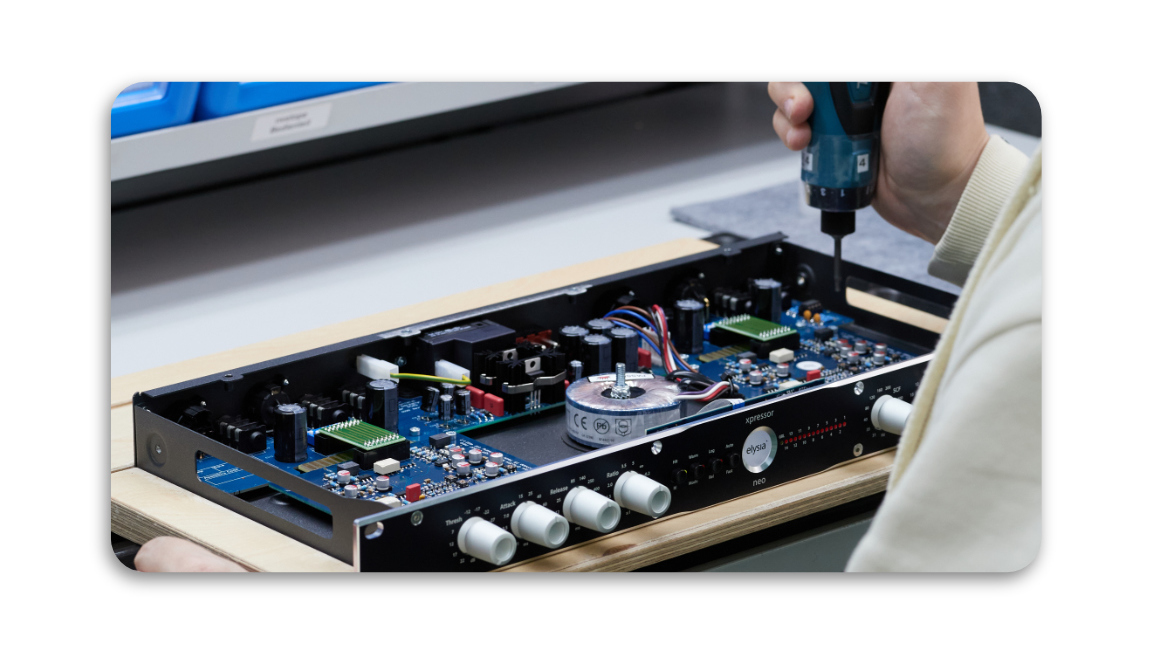
How do you get your favorite analog audio processors side by side of your laptop at home? What about your next tour or gig traveling the world?
We have unleashed our famous elysia analog audio processing hardware to make your musical life much easier, flexible and mobile with the elysia qube series.
A selected series of our famous 500-Analog Modules with Class-A Topology in a rugged, lightweight and travel-ready aluminium case with all the great pristine, transparent sound you will expect from us.
Analog to Go. Everywhere.
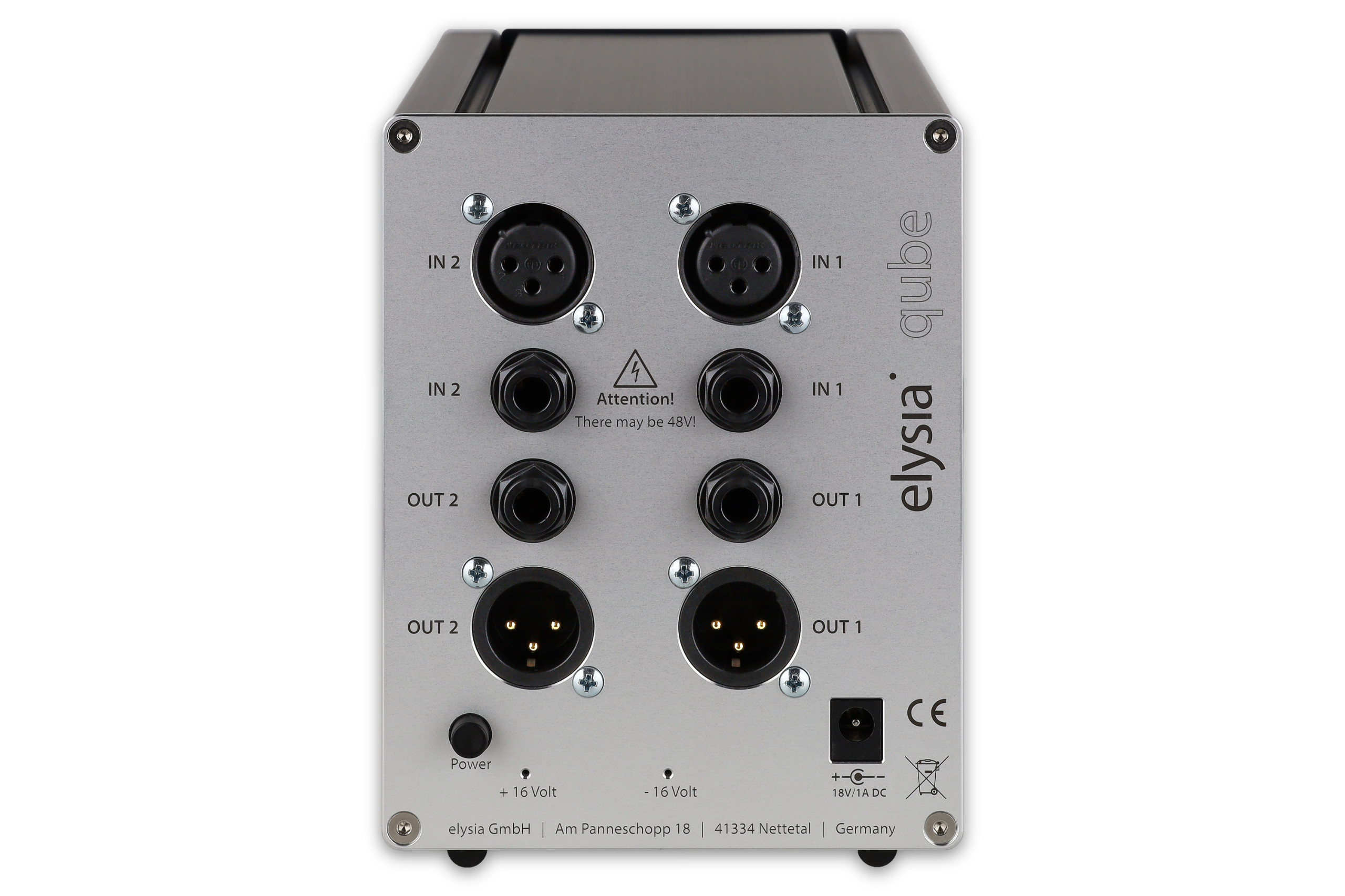
Total Gain range:
3 – 65 dB in 1.5/2 dB steps
Frequency response:
@ 3 dB Gain:
@ 29 dB Gain:
10 Hz – 170 kHz (-3 dB)
10 Hz – 170 kHz (-3 dB)
THD+N @ 6 dBu, 20 Hz – 22k Hz:
@ 3 dB Gain:
@ 29 dB Gain:
0.007%
0.007%
Noisefloor 20 Hz – 20 kHz (A-weighted):
@ 3 dB Gain:
@ 29 dB Gain:
-97 dBu
-93 dBu
Common Mode Rejection Ratio @ +6 dBu out level, 29 dBu gain:
@ 1 kHz:
@ 10 kHz:
+87 dB
+69 dB
Maximum input level:
Mic:
DI:
19 dBu
19 dBu
Impedance:
Mic Input:
DI Input:
Output:
13.6 KOhm
1 MOhm
62 Ohm
Dimensions (W x H x D, incl. Knobs):
4,09” x 5,39“ x 8,1“
104 mm x 137 mm x 205 mm
Weight (elysia qube):
3,04 lbs / 1,38 kg
Power consumption:
elysia qube:
500 Series Module:
8 Watts
90 mA
Are you passionate about recording studio-quality audio from the comfort of your home? Do you dream of producing professional-grade podcasts that captivate your audience? Look no further than the skulpter Preamp – a revolutionary device designed to enhance your recording experience and deliver impeccable sound quality.
Transform Your Home Studio: No matter the size of your studio space, skulpter is your secret weapon for transforming it into a professional recording haven. This compact yet powerful preamp offers exceptional versatility, accommodating a wide range of microphones and instruments. Whether you’re recording vocals, acoustic guitars, or even drum overheads, skulpter ensures optimal signal integrity and remarkable sonic clarity.
Effortless Workflow, Maximum Results: skulpter is designed with your workflow in mind, streamlining the recording process for seamless creativity. Its user-friendly interface and intuitive controls make it a breeze to dial in the perfect settings, saving you time and effort. Focus on your performance, knowing that the elysia|skulpter’s precise tonal sculpting and intelligent EQ section will enhance your sound with minimal effort.
Perfect Your Podcasts: Podcasting is on the rise, and quality audio is key to engaging your listeners. skulpter empowers you to create impactful podcasts that stand out from the crowd. Its transparent sound reproduction brings out the richness of your voice, while the intuitive controls allow you to effortlessly shape your sound to perfection. Elevate your podcasting game and deliver a listening experience that keeps your audience coming back for more.
Copyright @ 2024 elysia GmbH. All rights reserved. Am Panneschopp 18 | 41334 Nettetal | business hours from monday until friday from 9:00 to 17:00h (CET)
We need your consent before you can continue on our website. If you are under 16 and wish to give consent to optional services, you must ask your legal guardians for permission. We use cookies and other technologies on our website. Some of them are essential, while others help us to improve this website and your experience. Personal data may be processed (e.g. IP addresses), for example for personalized ads and content or ad and content measurement. You can find more information about the use of your data in our privacy policy. You can revoke or adjust your selection at any time under Settings.
If you are under 16 and wish to give consent to optional services, you must ask your legal guardians for permission. We use cookies and other technologies on our website. Some of them are essential, while others help us to improve this website and your experience. Personal data may be processed (e.g. IP addresses), for example for personalized ads and content or ad and content measurement. You can find more information about the use of your data in our privacy policy. Here you will find an overview of all cookies used. You can give your consent to whole categories or display further information and select certain cookies.